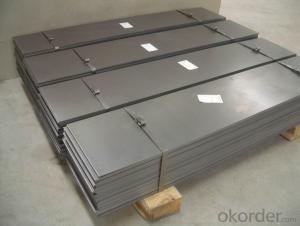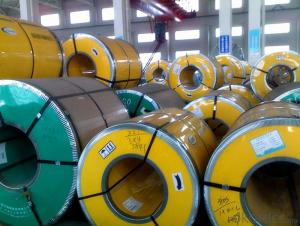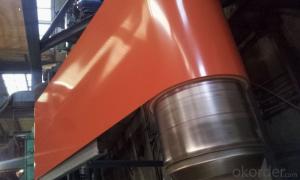Pre-painted Galvanized/Aluzinc Steel Sheet Coil with Prime Quality and Lowest Price color is red
- Loading Port:
- Shanghai
- Payment Terms:
- TT OR LC
- Min Order Qty:
- 100 m.t.
- Supply Capability:
- 10000 m.t./month
OKorder Service Pledge
OKorder Financial Service
You Might Also Like
1.Structure of Pre-painted Galvanized/Aluzinc Steel Coil Description
With GI (aluzinc) as base metal, after pretreatment (degrease and chemical treatment) and liquid dope with several layers of color, then after firing and cooling, finally the plate steel is called pre-painted galvanized (aluzinc) steel. Pre-painted galvanized steel is good capable of decoration, molding, corrosion resistance. It generally displays workability, durability and weather resistance.
2.Main Features of the Pre-painted Galvanized/Aluzinc Steel Coil
• Excellent corrosion resistance
• Excellent weather resistance
• Capability of decoration, molding, corrosion resistance
• Workability, durability
• Excellent heat resistance performance
• High strength
• Good formability
• Good visual effect
3.Pre-painted Galvanized/Aluzinc Steel Coil Images

4.Pre-painted Galvanized/Aluzinc Steel Coil Specification
Quality standar: JIS G3312 CGCC & CGLCC
Hardness of P: Both soft and hard quality are available
Surface finish: with or without protect film
Thickness : 0.14-1.20 mm
Width : 914mm, 1000mm, 1220mm and 1250mm, thickness 600-1250mm is available
Finish by coil or sheet: Both sheet and coil are available
8Zinc coating: 60-275G/M2, both sides
Paint thickness for top side : 5 micron primer + (10-20) microns modified polyester, blue color code.
Paint thickness for back side: (5-10) microns Epoxy
Weight per coil: 4-6 tons, also can be upon customer's requirements
Max loading weight in one 20ft container : 25 tons generally
5. FAQ of Pre-painted Galvanized/Aluzinc Steel Coil
We have organized several common questions for our clients,may help you sincerely:
1. What is the minimum order quantity ?
Our MOQ is 50mt for each size. And we will consider to give more discount if you make big order like 1000 tons and more. Further more, the more appropriate payment term your offer the better price we can provide.
2. How long can we receive the product after purchase?
Usually within thirty working days after receiving buyer’s advance payment or LC. We will arrange the factory manufacturing as soon as possible. The cargo readiness usually takes 15-25 days, but the shipment will depend on the vessel situation.
3. How to guarantee the quality of the products?
We have established the international advanced quality management system,every link from raw material to final product we have strict quality test;We resolutely put an end to unqualified products flowing into the market. At the same time, we will provide necessary follow-up service assurance.
- Q:Are steel strips used in the production of metal stampings?
- Yes, steel strips are commonly used in the production of metal stampings.
- Q:Can steel strips be used in the medical industry?
- Yes, steel strips can be used in the medical industry. Steel strips are versatile and can be used for various applications in the medical field. They are commonly used for manufacturing surgical instruments, medical implants, and medical equipment. Due to their strength, durability, and corrosion resistance, steel strips are ideal for applications where high precision and reliability are required. They can be easily shaped and formed into different medical devices, ensuring that they meet the specific needs of patients and healthcare professionals. Steel strips can also be surface treated to enhance their biocompatibility, making them suitable for implantable medical devices. The surface treatment can provide additional benefits such as reducing the risk of infections and promoting better integration with the patient's body. Moreover, steel strips offer excellent mechanical properties, allowing for precise machining and fabrication. They can be easily sterilized and cleaned, making them suitable for use in sterile environments. It is important to note that stainless steel is commonly used in the medical industry due to its resistance to corrosion and ability to withstand harsh sterilization processes. However, other types of steel can also be used depending on the specific requirements of the medical application. In conclusion, steel strips can be utilized in the medical industry for a wide range of applications. Their strength, durability, corrosion resistance, and ability to be surface treated make them a reliable choice for manufacturing surgical instruments, medical implants, and other medical equipment.
- Q:Are steel strips suitable for making electrical components?
- Depending on the specific application and requirements, steel strips can be utilized for the production of electrical components. Steel strips possess numerous advantages, including high strength, durability, and thermal conductivity, which render them suitable for certain manufacturing processes of electrical components. Examples of such components include electrical connectors, terminals, or busbars, where mechanical robustness and electrical conductivity are crucial factors. However, it is important to acknowledge that steel is not the optimal choice for all electrical components, particularly those necessitating high electrical conductivity or resistance to corrosion. In such scenarios, materials like copper or aluminum may prove more suitable. Moreover, considerations such as cost, weight, and specific electrical properties required for the component should also be taken into account before determining the appropriateness of steel strips for the production of electrical components.
- Q:How do steel strips perform in thermal insulation?
- Steel strips do not perform well in thermal insulation as they have high thermal conductivity, meaning they can easily transfer heat.
- Q:How are steel strips used in the production of household tools?
- Due to their durability and strength, steel strips find widespread use in the manufacturing of household tools. These strips serve as raw materials for various tools such as screwdrivers, wrenches, pliers, and hammers. Typically, steel strips are cut into specific lengths and widths before undergoing further processing to shape them into the desired tools. Manufacturers can bend, stamp, or forge these strips to create the necessary components for the tools. For instance, the strips may be bent to form the handles of screwdrivers or pliers, or they may be stamped into the jaws of a wrench. The use of steel strips in tool production offers several advantages. Firstly, steel is a robust material capable of withstanding significant force and pressure, making it ideal for heavily used tools. Secondly, steel exhibits high resistance to corrosion, ensuring that the tools remain in excellent condition even in harsh environments. Moreover, steel strips can be easily molded and shaped, allowing manufacturers to create tools with precise dimensions and intricate designs. This versatility in shaping steel strips enables the production of tools with ergonomic handles, textured surfaces for enhanced grip, and various other features that improve user comfort and efficiency. In conclusion, steel strips play a vital role in the production of household tools, providing durability, strength, and corrosion resistance. Their versatility allows manufacturers to create tools with precise dimensions and designs, resulting in high-quality and dependable products for everyday use.
- Q:Are steel strips susceptible to magnetization?
- Yes, steel strips are susceptible to magnetization.
- Q:How do steel strips behave under different loading conditions?
- Steel strips behave differently under different loading conditions. When subjected to tensile loading, they elongate and narrow in width, while under compressive loading, they shorten and widen. Steel strips also exhibit shear deformation when subjected to shear loading, where they slide past each other. Additionally, steel strips may experience buckling under compressive loading, causing them to bend or buckle out of shape. Overall, the behavior of steel strips is influenced by the type and magnitude of the loading applied.
- Q:Can steel strips be used in the production of hydraulic systems?
- Steel strips are capable of being utilized in the production of hydraulic systems. Due to its remarkable strength and durability, steel is frequently employed in the manufacturing of hydraulic systems. The construction of numerous hydraulic system components, including cylinders, pistons, valves, and fittings, can be achieved using steel strips. By utilizing steel strips, these components can effectively endure the immense pressures and forces associated with hydraulic systems. Moreover, steel possesses resistance to corrosion and can withstand extreme temperature fluctuations, thereby rendering it a material of choice for hydraulic applications.
- Q:What are the load-bearing capabilities of steel strips?
- Steel strips have high load-bearing capabilities due to their inherent strength and resilience. They can withstand significant amounts of weight and pressure without deforming or failing, making them suitable for various applications in construction, engineering, and manufacturing industries. The load-bearing capacity of steel strips depends on factors such as their thickness, width, and quality, as well as the specific design and support structure in which they are used.
- Q:Can steel strips be used in electrical transformers?
- Yes, steel strips can be used in electrical transformers. Steel strips are commonly used as laminations in transformer cores to reduce eddy current losses and improve the efficiency of the transformer.
1. Manufacturer Overview |
|
|---|---|
| Location | |
| Year Established | |
| Annual Output Value | |
| Main Markets | |
| Company Certifications | |
2. Manufacturer Certificates |
|
|---|---|
| a) Certification Name | |
| Range | |
| Reference | |
| Validity Period | |
3. Manufacturer Capability |
|
|---|---|
| a)Trade Capacity | |
| Nearest Port | |
| Export Percentage | |
| No.of Employees in Trade Department | |
| Language Spoken: | |
| b)Factory Information | |
| Factory Size: | |
| No. of Production Lines | |
| Contract Manufacturing | |
| Product Price Range | |
Send your message to us
Pre-painted Galvanized/Aluzinc Steel Sheet Coil with Prime Quality and Lowest Price color is red
- Loading Port:
- Shanghai
- Payment Terms:
- TT OR LC
- Min Order Qty:
- 100 m.t.
- Supply Capability:
- 10000 m.t./month
OKorder Service Pledge
OKorder Financial Service
Similar products
New products
Hot products
Related keywords



























